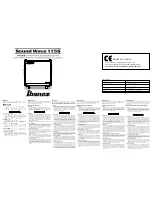
Contents
Introduction ……………………………………….1
Contents/For the Record ………………………….2
Safety ………………………………………...3 & 4
Special Features ………………………………..5-7
Front Panel Features ……………………………...8
Rear Panel Features ………………………………9
Installation …………………………………..10-13
Trouble Shooting ……………………………14-15
Technical Information ………………………16-17
For The Record
Please fill out and return the enclosed warranty card at
your convenience. This information will provide proof of
ownership for warranty purposes and will allow us to
notify you if necessary.
In the spaces provided below, record the model and
serial number located at the rear of your amplifier.
Model No. ________________________________
Serial No. _________________________________
Purchase Date _____________________________
Retain this information for future reference.
2
Troubleshooting Reference Chart
Symptom: Recommended Action:
No output: Power indicator LED is off Be sure power outlet is “live”. Be sure
(Note: there is a normal delay of up power switches are “on”. Check circuit
To 1 minute when amp is first breaker. Wait 1 minute after plugging
plugged in or circuit breaker is reset.) in cord or resetting breaker.
___________________________________________________________________
No output: Power indicator LED This indicates a short-circuit
Cycles on and off. Condition on the output. Disconnect
speaker wires and turn amplifier
power switch on. If amp stays on, the
problem is in the output wiring or
speakers.
___________________________________________________________________
Power indicator on: no output from Check input level controls, input and
one or both channels. Output cables, input signal and
speakers. If operating in bridged mode,
be sure connections are made to
Channel 1’s inputs.
___________________________________________________________________
Low volume in one or both channels. Check input level controls, input signal
levels, and input wiring. Be sure both
speakers are the same impedance.
___________________________________________________________________
Amplifier overheats and/or shuts off. Review section on Thermal
Considerations. Note that overdriving
amplifier for a long period can cause
thermal shutdown. Note that
overdriving amplifier hard enough can
cause momentary shutdown.
___________________________________________________________________
Distorted output. Check signal level and signal source.
Check speaker(s).
___________________________________________________________________
Noise on output. Check signal source for noise. If you
are running input cables of more than 30
feet, balanced lines can reduce noise
levels considerably. See sections on Input
and Output wiring for more information
on wiring balanced lines.
15




























